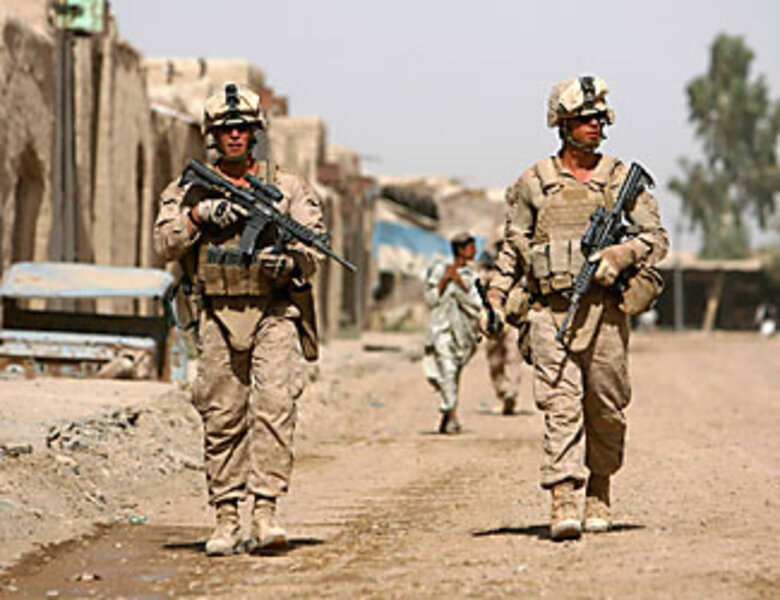In Afghanistan operation, Marines return to 'little America'
Loading...
| New Delhi
The area where US Marines just launched one of their biggest operations in recent years was once known as "little America." During much of the cold war era, American expertise and money poured into Helmand Province, raising up towns from the desert through a massive irrigation project.
Nearly 4,000 marines, along with hundreds of Afghan forces, pushed deeper into the southern districts of Nawa and Garmsir after launching their strike yesterday from Camp Leatherneck, a newly built base in central Helmand.
Resistance so far has proved light – something that analysts say may indicate the insurgents have decided to pack up and take their fight elsewhere. The military reported that one marine was killed Thursday, and several wounded. Friday reports were unavailable.
"When military forces push into one area, it tends to just push the conflict into other areas," says Nic Lee, director of the Afghanistan NGO Safety Office. "It's like moving pieces around a chess board."
As the marines move south down the Helmand River, they are probably passing through towns that would not exist but for the American water-works assistance, says Richard Scott, an agricultural expert who has worked on the project over decades. Yet the US-backed Afghan government has lost control of these parts of Helmand to Taliban insurgents, and the US is now trying to win them back.
Indeed, the cold war rivalry with the Soviet Union touched off an American undertaking in Helmand that's been compared in scope with the Tennessee Valley Authority. And it could reemerge in American consciousness through the new military mission's emphasis on hearts and minds.
The geography of where the fight is
Writer Ambrose Bierce once quipped that "War is God's way of teaching Americans geography." Helmand is Afghanistan's largest province, and lies west of Kandahar and north of Pakistan in the country's south. The Helmand River Valley runs across much of the length of the province, from the hill-country of the north down to the flat and dry deserts of the south.
Larger cities and settlements lie in the north. Mr. Scott describes central Helmand – where the offensive began – as "a tennis court with gravel spread on it."
The journey south moves into progressively hotter and drier regions, places that top 100 degrees Fahrenheit by May and see only a few inches of rain a year.
Irrigation efforts have spread farming beyond the floodplain of the river, giving rise to the desert towns that the marines are moving through.
As of Friday evening, US forces said they had pushed as far south as Khan Neshin, the capital of Rig District, where the river begins curving to the west, toward Iran.
The areas they are entering, says David Isby, an Afghanistan expert, "are small towns. The district capitals will have [government offices], a police station, a small bazaar, and that's about it."
The Helmand-Arghandab Valley Authority
Even that level of development might not exist but for the big investment in water infrastructure known as the Helmand-Arghandab Valley Authority project.
The American government spent $72 million on the project between 1957 and 1979, and earlier helped financed another $39.5 million through Export-Import Bank loans. The Afghan government chipped in an additional $25 million.
The irrigation project irrigated tens of thousands of hectares in Nawa and Garmsir, as well as several other central districts. As an extra enticement to settlers – many of them nomadic peoples – US contractors helped build schools systems and even constructed the current capital of Lashkar Gah in a desert region of ancient ruins.
"It was a huge influx of people who came in there for the land settlement," says Scott, who worked on the project for USAID in the 1970s. "It was really a thing to get free land [and] an educational system right there in the villages."
Scott has returned in recent years to help villagers repair the irrigation systems damaged during decades of war. Repair work ended definitively in 2005, after insurgents killed a truckload of Afghan engineers working on the project.
Goodwill, but tempered by recent casualties
But at least until that time, says Scott, there remained local goodwill for the American endeavors there over the decades.
"Among the descendants of all the settlers, these people know and knew what we had done for them," says Scott.
He says some of that local support may be draining due to anger over civilian casualties.
The new US commander in Afghanistan, Gen. Stanley McChrystal, has signaled that more care will be taken to avoid civilian casualties and to winning over the local population.
The Marines said that they, along with Afghan counterparts, "have begun engaging with key leaders in the districts in order to better understand the concerns and needs of the Afghans in the area."
Scott says he can guess what those Afghan leaders would say – the same thing they have told him since 1997, when he asks what it would take to end poppy cultivation there: "They said, work on the irrigation system, work on the drainage system, and use hand labor so you put everybody to work for pay."
Follow us on Twitter.





